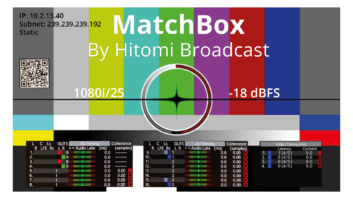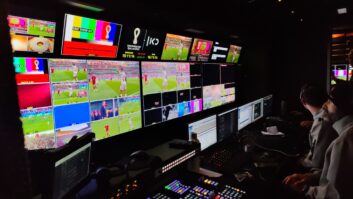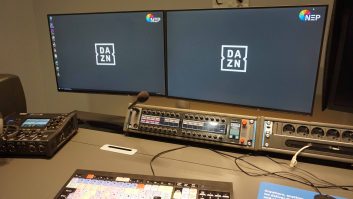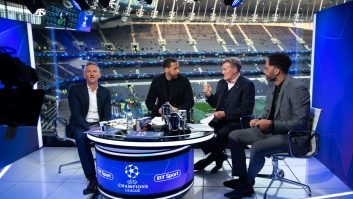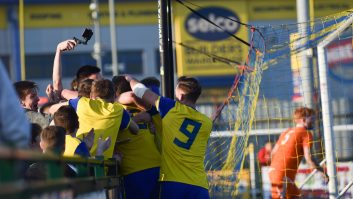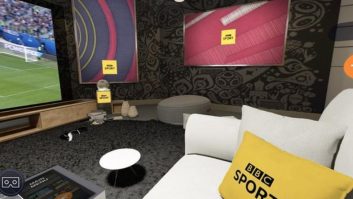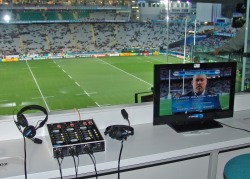
Digital technology has pushed its analogue counterpart on to the sidelines in most areas of sports broadcasting but commentary is one vital element for which this has not happened completely. Today the two audio formats appear to have settled into a co-existence, giving operators the choice of what best suits their needs, writes Kevin Hilton.
Choices exist among the three types of common commentary system configuration: ISDN, POTS/PSTN (plain old telephone service/public switched telephone network) or IP codecs for single reporter use; stand-alone units, which have more features but are still run on site by the commentary team; and more sophisticated systems, with control and processing sections the responsibility of an engineer.
Among codec mixers used for sports commentary are the AEQ Phoenix Mobile, Glensound Electronics GS-GC units and the Mayah Communications range. The Sporty PSTN, ISDN, WLAN, UMTS/3G mobile codec is used mainly by small European commercial radio stations, but Mayah spokesman Daniel Adasinskiy says in December the company is due to launch specific features to make the unit more suitable for TV sports commentary.
The next step up from the mixer codec is the stand-alone commentary system. At its most basic this has inputs for two microphones and outputs for two headphones, one each for the commentator and the former player or out-of-work manager providing the ‘expert’ analysis; more recent models have positions for two or three commentators and one guest.
OB operator SIS LIVE works with the BBC and other broadcasters on sports and entertainment coverage. Vision Engineer Neville Orton comments that for typical sports events, such as football matches, where one or two positions are required, analogue stand-alone commentary units such as the Prospect Electronics CMU21 or Glensound GS-CU001 are used. “These have outputs and inputs on standard XLRs to the OB truck using standard multi-quad cable, which is used across our fleet and within the industry,” he explains.
Also in the stand-alone bracket are the Sonifex CM-CU21, an analogue desk with two commentator positions and one for a pundit, and the DC2012, manufactured by OB equipment specialist CTP Systems. Succeeding the DC99-II, the two position DC2012 is analogue but has digital control. Managing Director Chris Thorpe says the OB companies he supplies, which include Visions, want something “that will work wherever”. A wholly analogue single commentator unit, as yet unnamed, is due for launch this month.
Digital age
Completely digital commentary systems caused consternation when they first appeared during the early 2000s. The concern was that they would be too unreliable and complicated to use. Spanish manufacturer AEQ persevered and its DCS-10 is now the preferred commentators’ system for the Olympic Games.
AEQ is now promoting a successor to the DCS-10, known within the company as the NCS. Both systems have three mic and three headphone connections, with an additional mic/line input for a guest. Each is connected to a central control unit; in the case of the NCS this is a standard AEQ BC-2000 router.
In 2008 Glensound launched its own digital system, the GDC-6432. Like the DCS-10 system, this comprises a commentator’s desk and a control unit, which is run by an engineer either in the commentary box or an OB truck, linked digitally over coax, copper or fibre Ethernet.
Gustavo Robles, director of international sales at AEQ, says digital commentary systems are now commonplace but that cost is still a deciding factor: “All is in relation to the size of event and the budget available. Analogue does still have a place since it is easy to deploy and operate. However, at larger events, the digital domain is becoming more important.”
A recent outing for the Glensound GDC-6432 was the Rugby World Cup in New Zealand. Gearhouse Broadcast provided 37 GDC-6432s to facilities operation OSB NZ, which provided facilities to host broadcaster Sky NZ.
SIS Live Sound Supervisor Andy James comments that large-scale events such as the Olympic and Commonwealth Games are now more likely to feature digital commentary systems because of the need for central control and scalability. “Digital enables us to increase or decrease the number of commentary systems offered to the client broadcasters without re-designing the system,” he says. “The digital systems also integrate more easily with a fibre infrastructure than analogue kit does and this enables us to reduce cable and rigging time and pass on savings to the customer.”
Digital matrix
Finnish public broadcaster YLE is beginning to move to digital, although it still has Glensound GS-OC24 commentators’ units and GS-OC23 base stations in operation. Senior Technical Advisor Matti Helkamaa comments that YLE’s stand-alone systems are now shifting from ISDN to IP with a full Riedel set-up, connecting either DSC-16 panels with modified mic preamps or CCP-1116 commentary units to the German manufacturer’s intercom systems.
“The old analogue commentary units at YLE will be in production according to their remaining lifespan but the transition is towards digital matrix systems,” Helkamaa says. “Even in relatively small units we have digital matrix based intercom systems because of the stability and versatility.”
Riedel and fellow Germany company Delec, with its oratis commentators’ panels and intercom system, are the leading proponents of carrying commentary feeds on the same circuits as communications and the main audio. While neither Glensound nor intercom manufacturer RTS/Telex is immediately following this trend, the two recently collaborated to produce the COIN GT-013, which combines commentary and talkback front-end functionality in a single box.
There is concern among both broadcasters and other manufacturers that having commentary on the same carrier as other audio feeds is a risk, with the chance that the commentator circuits could go down if there is a break in the connection, as happened during the live first semi-final of this year’s Eurovision Song Contest.
Integrated future
Despite this, Riedel sees full integration as the future. “If you look at contemporary installations and how many different systems and signals are distributed side by side, it makes a lot of sense to us to use one single integrated infrastructure, both in terms of installation and maintenance,” comments spokesman Nils Quak.
On this issue YLE’s Matti Helkamaa says, “We favour the integrated thinking pattern for production. The Riedel intercom system is by its nature an AES router and we are utilising this feature as well. It is an advantage to have the commentary signals in and out as well as a full set of intercom connections with one single cable.”
Andy James at SIS Live is more circumspect: “On large scale systems we currently favour keeping commentary systems separate from main multilateral circuits as it offers an extra level of redundancy should the main circuits fail. A broadcaster could continue to commentate if they lost pictures. However, the potential cost savings in using systems that combine video, audio and communications circuits mean we will always consider their use, provided there is sufficient redundancy in the system.”
The question of to combine or not combine the commentary with other signals will continue to be the biggest faced in this small but important area of sports broadcast technology over the next few years. Armchair fans will mostly be oblivious to this; the main requirement continues to be to hear what the commentator says — and vehemently disagree with it.
